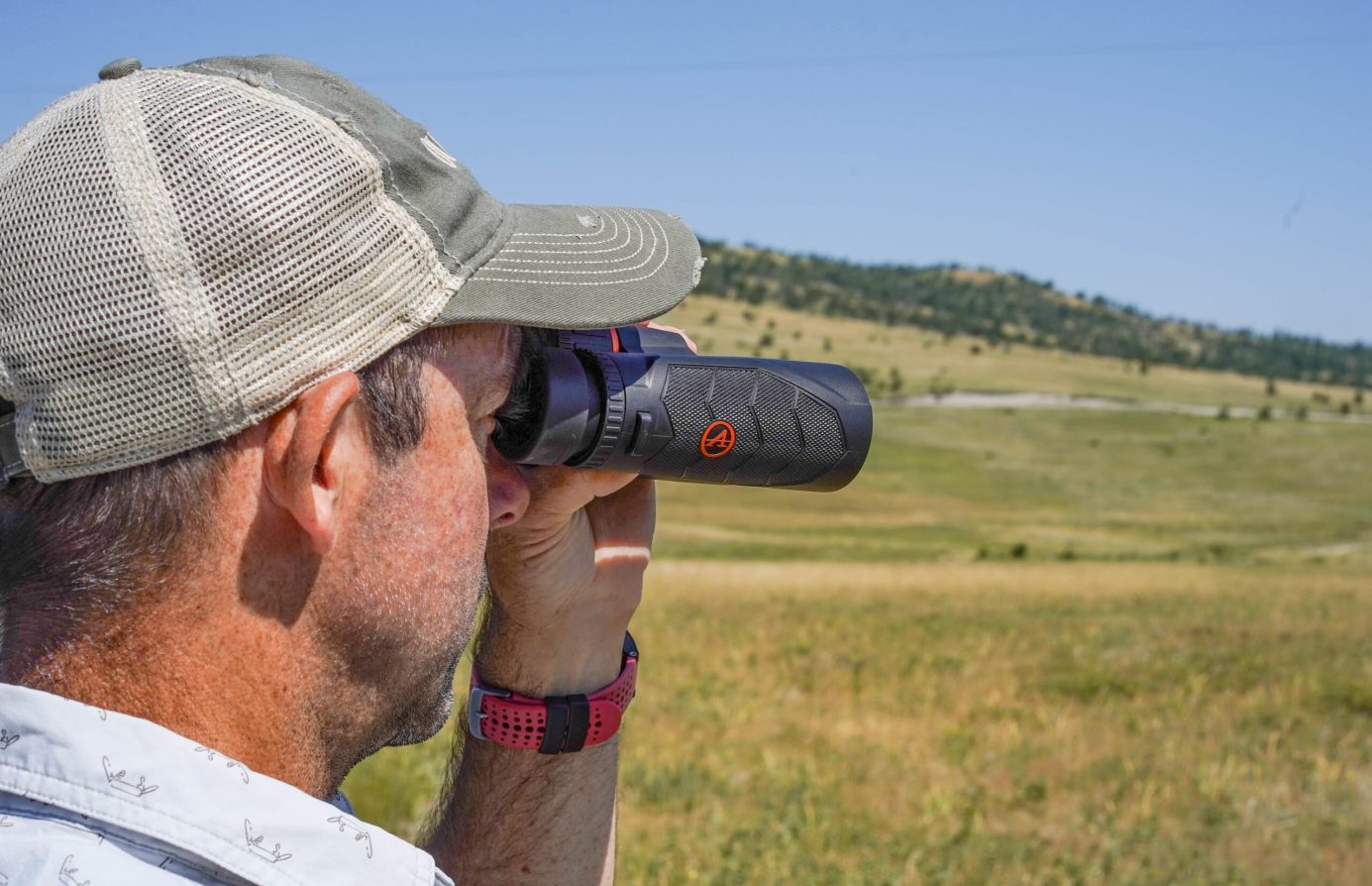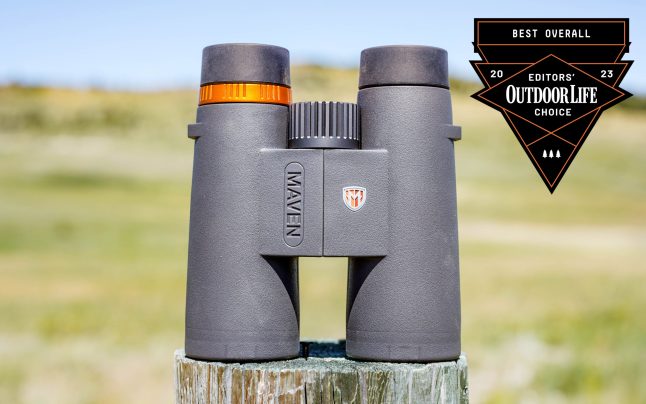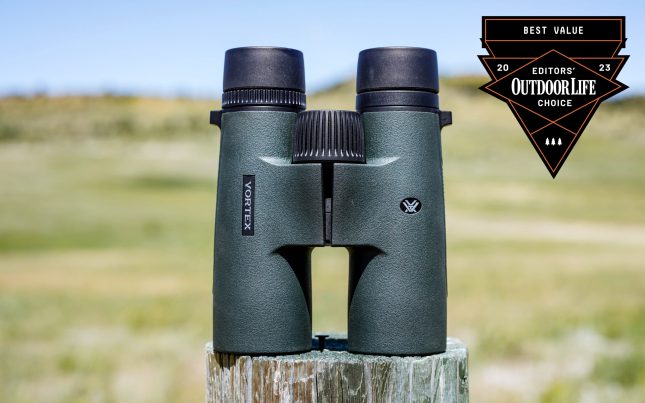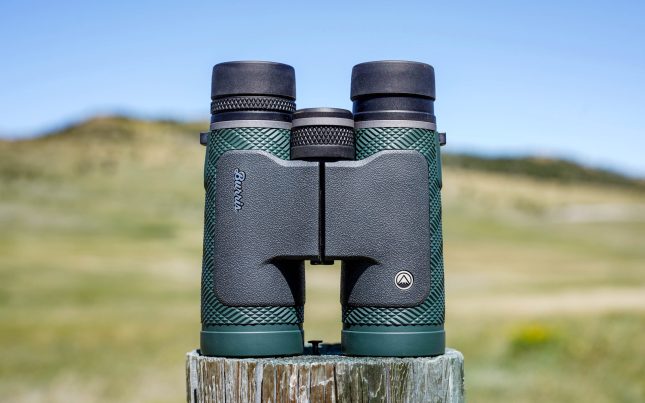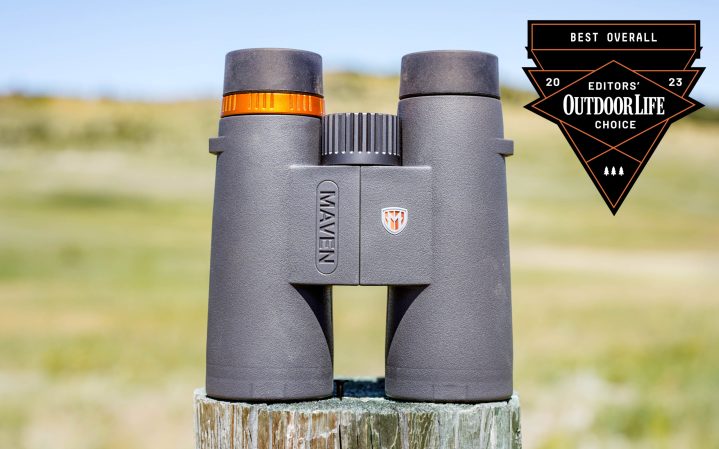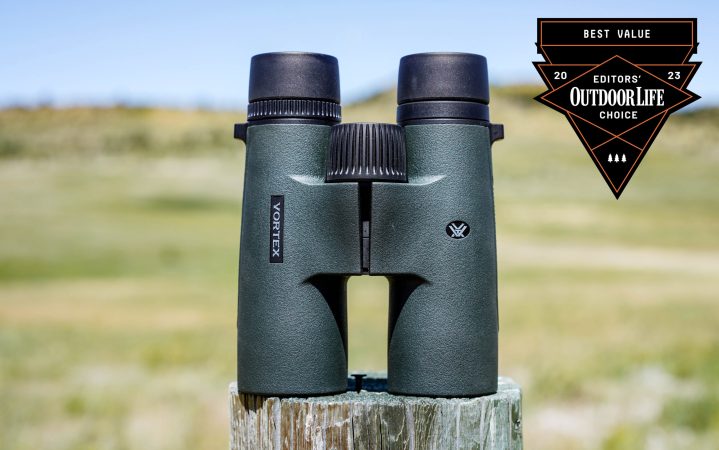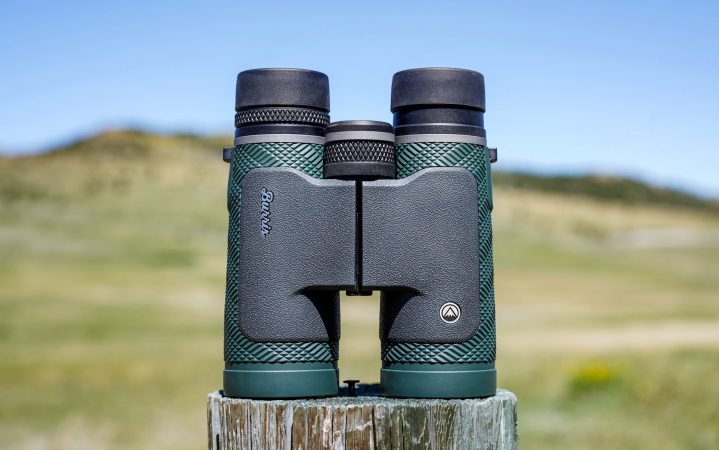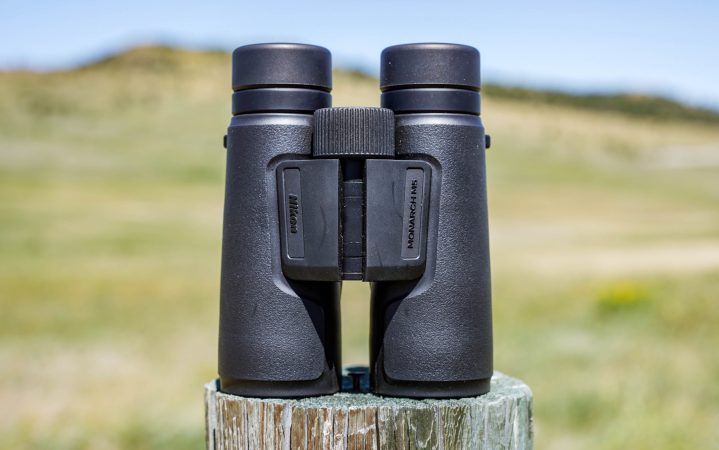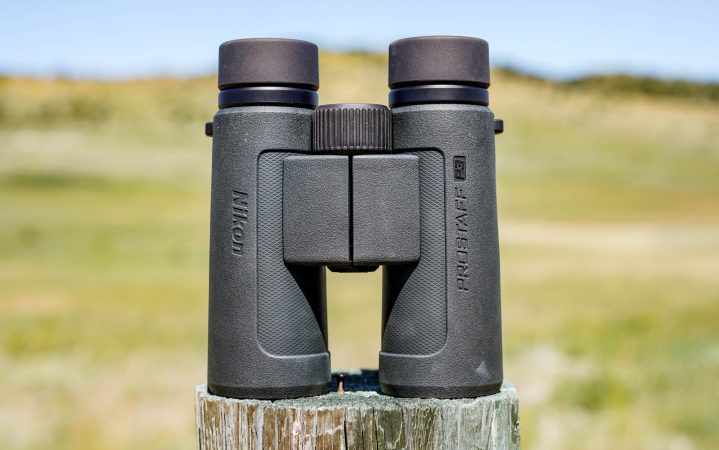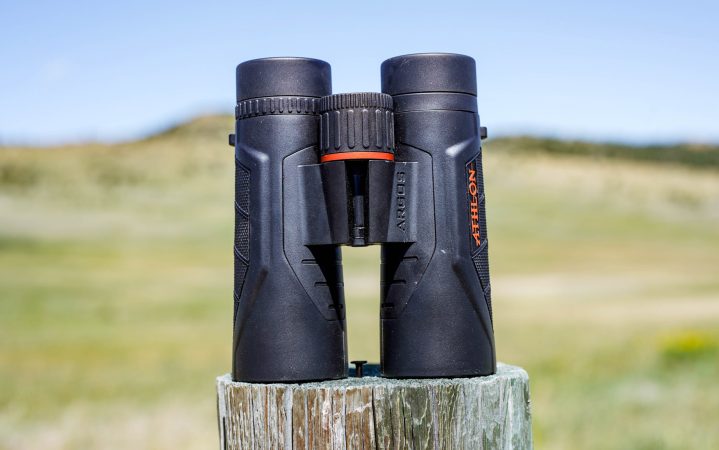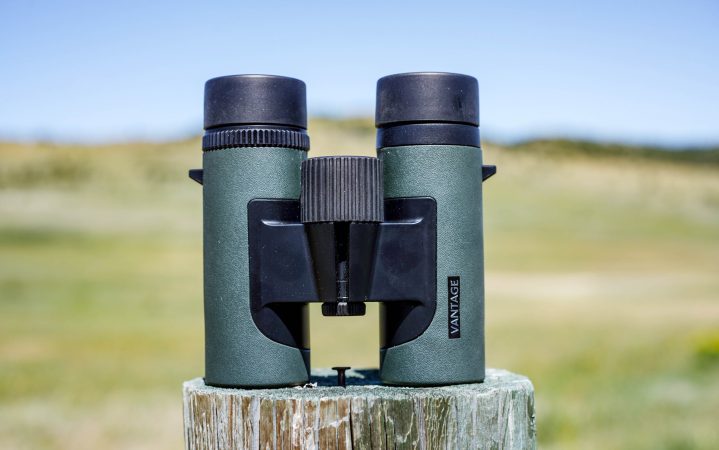We may earn revenue from the products available on this page and participate in affiliate programs. Learn More ›
Binoculars are among the most critical pieces of gear for most of us who spend time outdoors. Hunters, hikers, birders, shooters, wildlife watchers, even search-and-rescue personnel all rely on binoculars to better see the world.
Even if the design of binoculars—parallel magnified tubes with a common focus control—is fairly standard, prices for binoculars are all over the map, ranging from the price of a tough steak dinner all the way up to several thousand dollars. We wanted to test models that are in the sweet spot for most readers, the best binoculars for the money that cost less than $400. That’s the basis for our first-ever budget binocular test, in which we put eight reasonably priced binoculars through a head-to-head test of their optical attributes and overall handling.
We invited manufacturers to submit any new binoculars introduced from mid-2022 through 2023. But this year for the first time, we also welcomed binoculars that have been on the market for a few years. This budget-binocular test aimed to produce a true buyers’ guide.
- Best Overall: Maven C.1 8×42
- Best Value: Vortex Triumph HD 10×42
- Burris Droptine HD
- Nikon Monarch M5 8×42
- Nikon Prostaff P3 10×42
- Athlon Argos G2 UHD 10×42
- Leupold Alpine HD 10×42
- Hawke Vantage 8×32
How We Tested the Best Binoculars for the Money
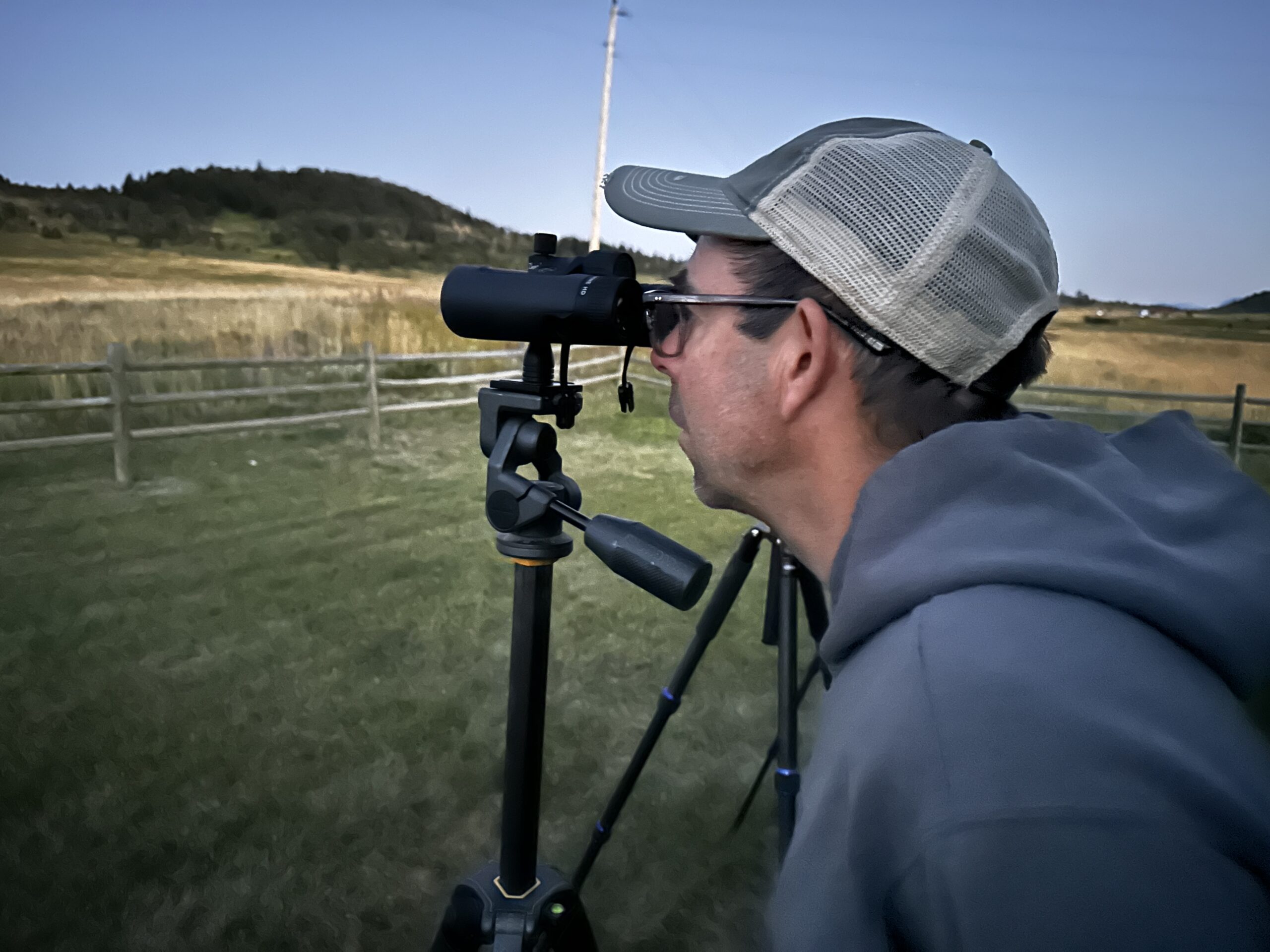
We put all submissions through the same criteria. First, we measure optical resolution, using the diminishing black-and-white lines of a 1951 Air Force Resolution Target to score the optical performance of each submission. We also measure the low-light performance of each binocular by mounting them to tripods and focusing them at 200 yards at a black-and-white resolution target at twilight, all in order to measure the brightness of the glass. This is an important consideration for hunters, since game animals move more in the early morning and late evening than at any other time.
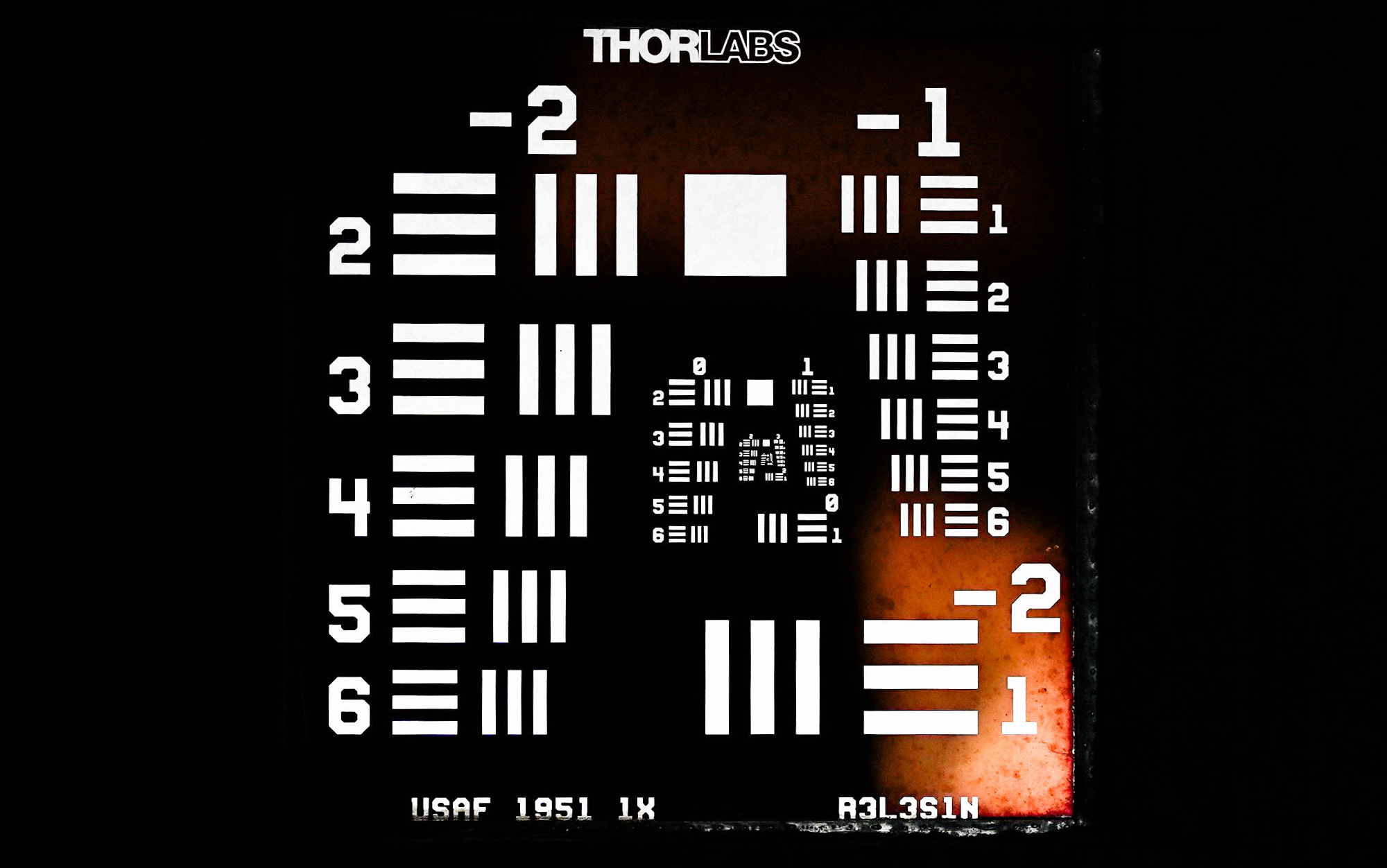
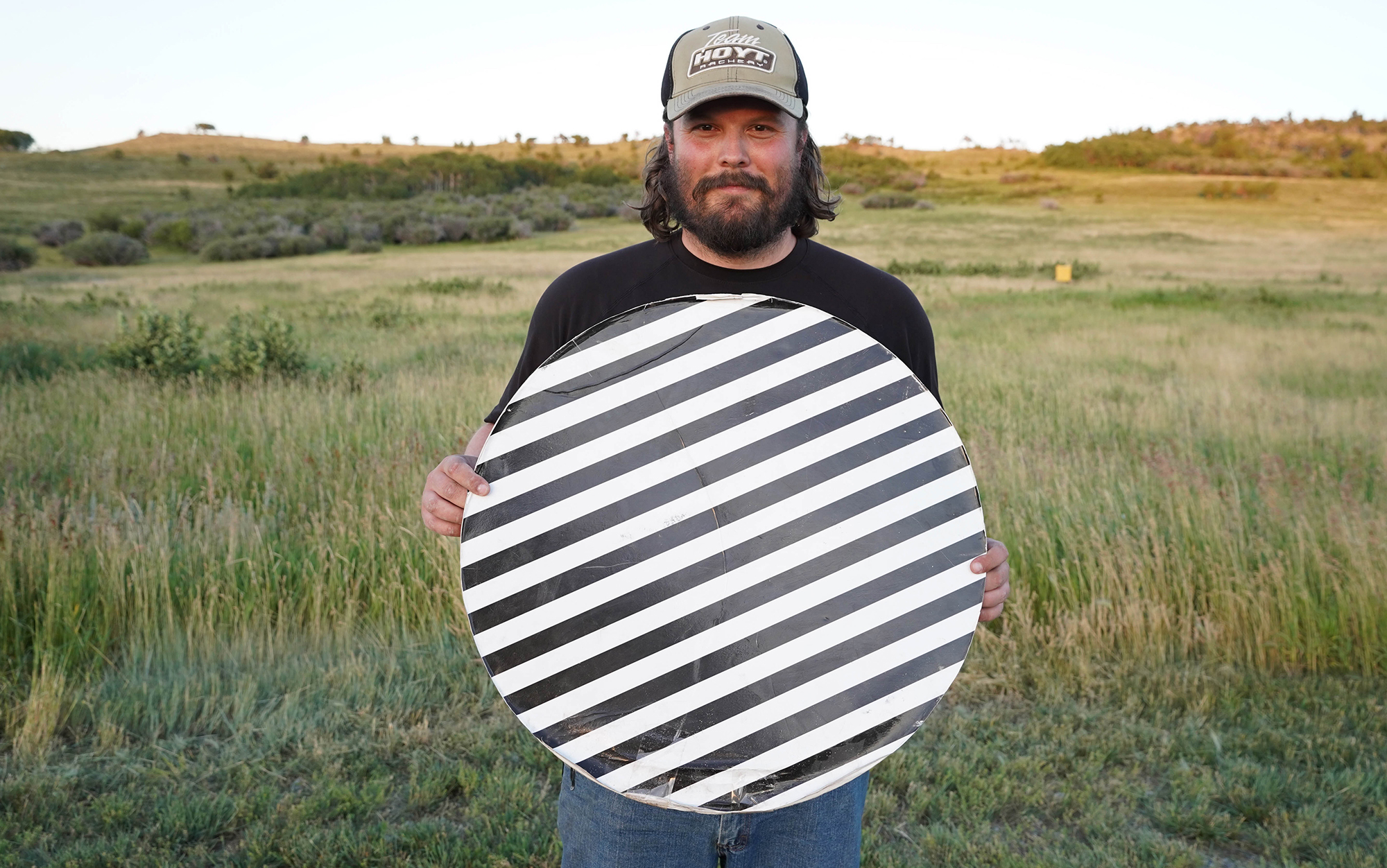
The binocular that can “see” the longest into the gathering darkness gets top marks. The model that loses its night-vision earliest gets the lowest score. Binoculars in the middle receive weighted scores somewhere between those two poles.
How We Score and Grade Optics
We break our 10-point scoring into four general categories: optical performance, mechanical performance, design, and value. The average of these categories is the basis of our grades, detailed below.
Optical performance includes the resolution and low-light tests plus the more subjective assessments of image quality and brightness. Mechanical performance assesses the durability of the submission along with its controls: focus and diopter controls, eyecup extension and comfort. Design considers the exterior finish, interior blacking, tripod mount, and its innovation and versatility along with its comfort. We ask testers to evaluate this critical question: how long could you glass with this binocular?
And then our price/value score rates how much optic—along with warranty and amenities such as carrying case or harness—you’re getting for your money. The binocular that gets the highest overall score wins our Editor’s Choice award for the best in the category; the optic with the highest price/value score wins our Great Buy recognition.
Grading
Our 10-point evaluation adds up to a total numeric score, but we translate those to grades for each submission. The Optical Performance grade combines the scores from resolution, low-light, image, and brightness. Our Mechanical Performance grade aggregates the mechanics and durability score. The Design grade considers Construction, Innovation, Versatility, and Comfort. And then the Price/Value grade is our value grade.
To earn an “Excellent” grade, the average of that category must be 9 or higher, which is extremely hard to achieve. “Very Good” is an average score of 7 to 9. A “Good” grade is 5 to 7. Our “Fair” grade is 3 to 25, and “Poor” is anything under 3.
Best Binoculars for the Money: Reviews & Recommendations
Best Overall: Maven C.1 8×42
Score Card
- Optical Performance: Very Good
- Mechanical Performance: Good
- Design: Good
- Price/Value: Very Good
Key Features
- Closed-bridge design
- Right-barrel diopter control
- Polymer frame
- Tripod adaptable
- Fully transferable lifetime warranty
Pros
- Distinctive orange accents
- Extra-low-dispersion glass in objective lenses
- Ships with microfiber bag and carry strap
- Also available in 10×42 and 12×42 models
Cons
- At $400, most expensive “budget” binocular
- Eyecup edges unforgivingly hard
In some ways, it was no surprise that this $400 binocular won our budget bino contest. Because Maven is a direct-to-consumer brand, with no retail mark-up, that $400 price point allows Maven to pack a better class of glass into the C.1 than a brand that must distribute products through normal retail channels. And, it must be noted, that the 10×42 version of the C.1 sells for $425, and the 12×42 version goes for $450.
But back to the 8×42 in our test. Its extra-low-dispersion glass (you’ll often see this called ED glass) allowed it to win our resolution test and deliver an excellent image, with sharp edge-to-edge clarity and very little color flaring. We were surprised by the middling performance in our low-light test, but that might be a product of the 8-power model; most submissions were 10-power.
The C.1’s aggressively textured focus wheel turns with precise authority. Same with the diopter ring. Some testers complained that eye cups felt flimsy and were so square and hard that they dug into users’ brows.
Generally, though, this is a durable, stylish, and extremely useful binocular. While it might stretch the definition of a budget optic, it should give you years of use, long after some of the cheaper binoculars have gone away.
Best Value: Vortex Triumph HD 10×42
Score Card
- Optical Performance: Fair
- Mechanical Performance: Good
- Design: Good
- Price/Value: Very Good
Key Features
- Single-hinge, closed-bridge design
- Roof-prism design
- Right-barrel diopter control
- Fully transferable lifetime warranty
- Tripod adaptable
Pros
- Ships with excellent GlassPak harness
- 22.9 ounces
- Extremely accessible price
Cons
- Significant peripheral distortion
- Flimsy feeling
How on earth can Vortex bring a capable binocular to the masses for under $100? With a premium harness and the brand’s legendary warranty? Those were questions our test team batted around as we handled this brand-new entry-level binocular. Then we got behind the lenses and learned some of the answers.
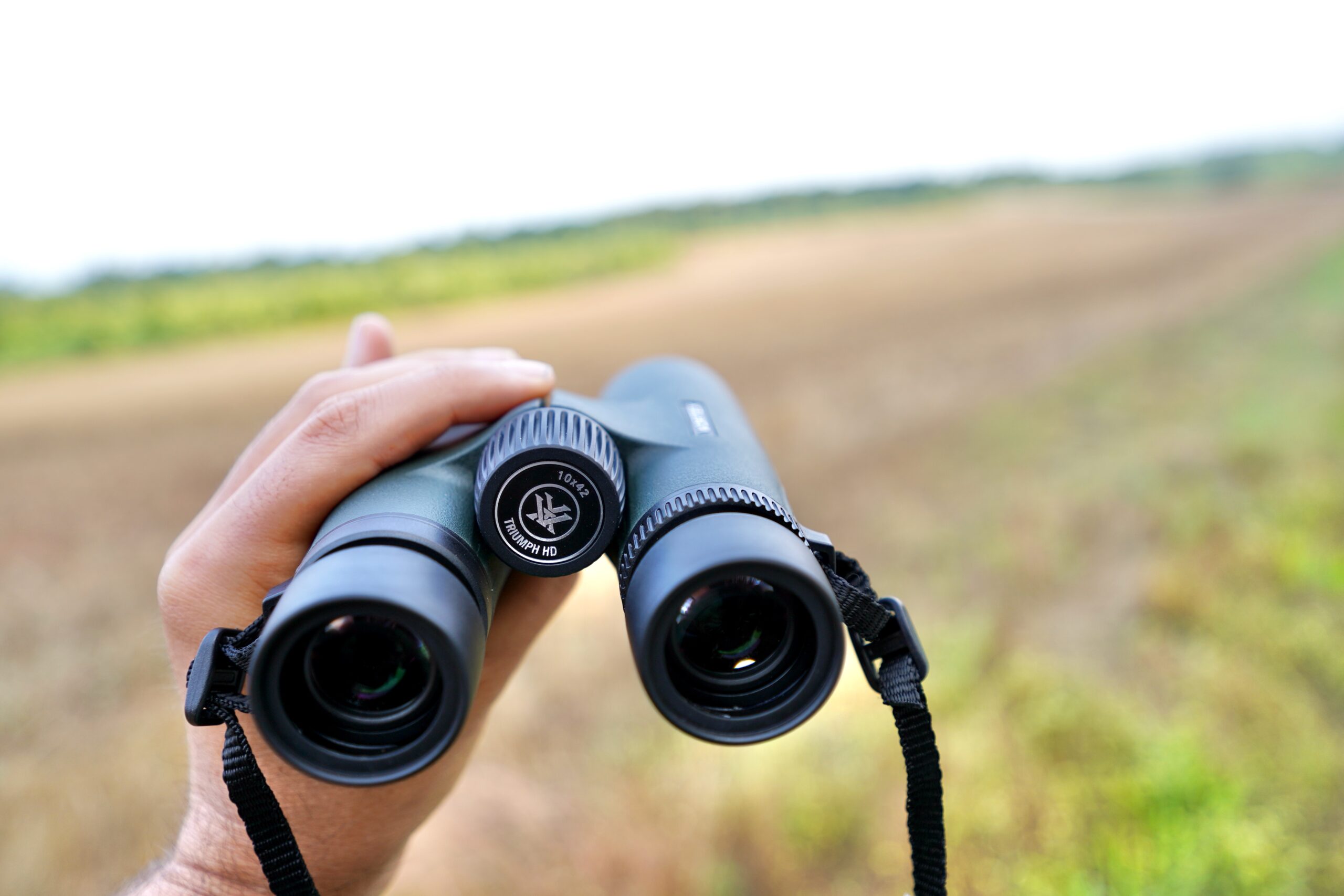
The biggest answer is the class of glass inside the new Triumph HD is cheap. The Vortex received uniformly downbeat assessments in optical performance; it scored near the bottom in low-light brightness, and its resolution score was just below the median. Testers further complained about blue color fringing, noticeable edge distortion, and blurry focus.
But we also recognized that you shouldn’t expect world-beating glass inside a $99 binocular, and that same realism pervaded our assessment of the Triumph’s mechanical performance. The diopter adjustment is stickier than we’d like, and the overall build feels flimsy. But the tapered eyecups move with positivity and the focus wheel is tight and responsive. The texturing, balance, and overall design is better than we’d expect for the price.
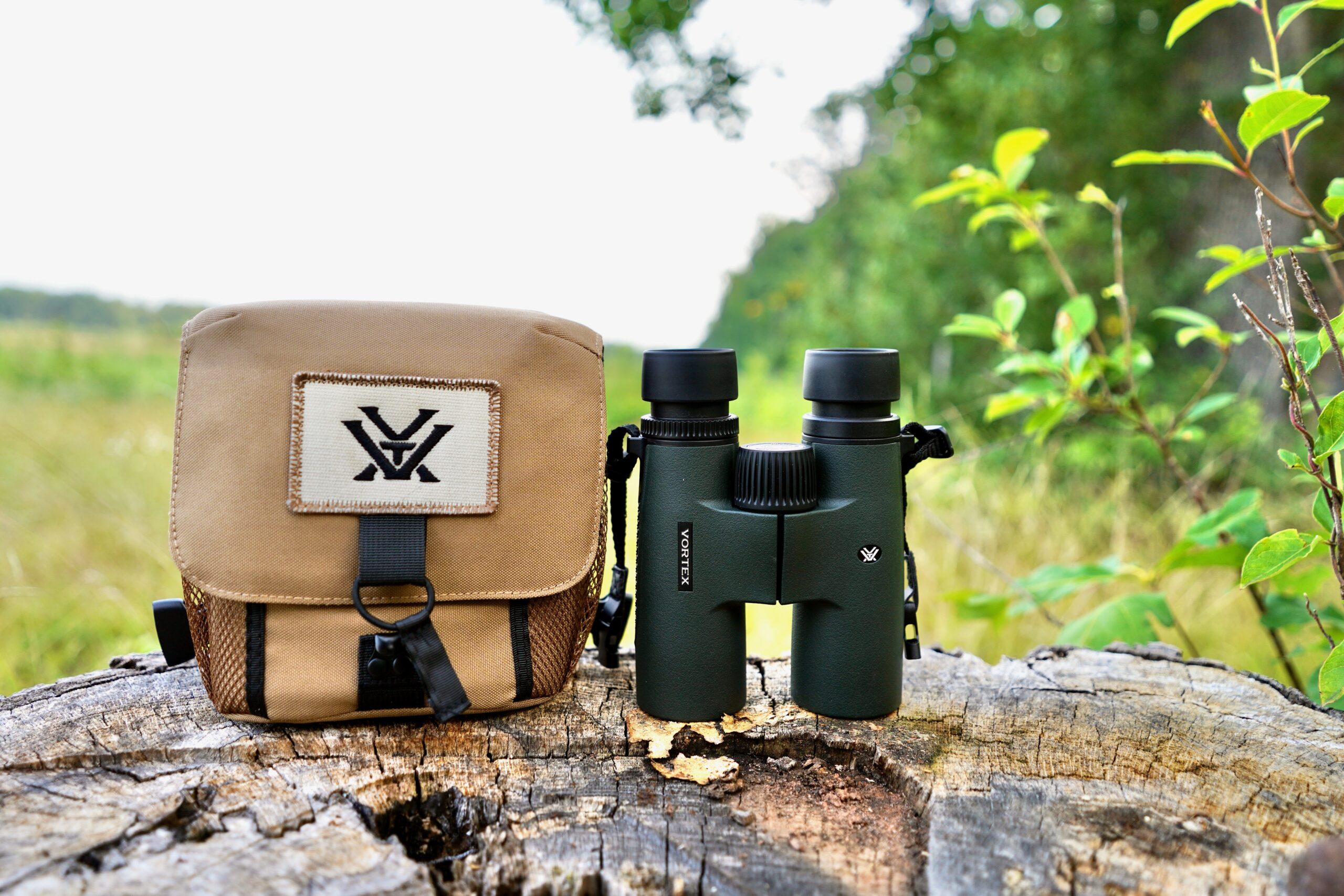
On the value side of the ledger, the GlassPak case and integrated harness confirms the Great Buy designation we gave the Triumph HD. This would make a very good first optic for a hunter, birder, or shooter, and if treated gently is a good choice to throw in a pickup or cabin. We’re not sure how much rough handling this bino can take, but Vortex’s excellent warranty and customer service is a cheering consolation.
Read our full Vortex Triumph review to learn more about this best binocular for the money.
Burris Droptine HD
Score Card
- Optical Performance: Good
- Mechanical Performance: Very Good
- Design: Good
- Price/Value: Very Good
Key Features
- Closed-bridge, roof prism design
- Right-barrel diopter control
- Metallic alloy body
- Tripod adaptable
- Ships with ballistic nylon strapped case
- Fully transferable lifetime warranty
Pros
- Distinctive black-and-brown styling
- Aggressively textured barrels
- Excellent low-light performance
- Long track record of performance
Cons
- Slight play in focus wheel
- Mediocre glass
Introduced in 2017, the Burris is one of a handful of “legacy” submissions in our test, but the strong finish of the Droptine HD indicates that it is still a very capable optic that won’t break your personal bank. It’s also worthwhile to note that these veteran products have a long track record of performance, an important consideration for would-be buyers who want to know what previous buyers thought about the product.
For our part, OL’s testers especially liked the full hand-feel of the Droptine, and most liked the checkered texture on the barrels. The resolution was right in the middle of the field, probably as a function of its mediocre glass. But testers recorded decent edge clarity and pleasing color renditions and contrast. In short, its optics aren’t distracting, but rather additive to its performance, which is a rare quality for a budget binocular.
Of course, we found some shortcomings. The focus wheel has noticeable slop, and a couple of testers found the image produced blue jags and slightly blurry focus. But overall, there’s a lot of performance in a solid package that, priced under $300, is one of the best binoculars for the money.
Nikon Monarch M5 8×42
Score Card
- Optical Performance: Good
- Mechanical Performance: Good
- Design: Very Good
- Price/Value: Very Good
Key Features
- Closed-bridge, roof prism design
- Right-barrel diopter control
- Fiberglass-reinforced polycarbonate resin body
- Premium glass and coatings
- Tripod adaptable
- Non-transferable lifetime warranty
Pros
- Extra-low-dispersion glass in objective lenses
- 8.2-foot close focus
- Wide field of view
- Very light weight (22.2 ounces)
- Appealing price
Cons
- Spongy focus
- Poor low-light performance
Nikon seems to have an inexhaustible supply of appealing price-point binoculars. We tested a very capable Prostaff in this test, and Nikon has been a stalwart of our good-optic-for-the-price binocular for at least 15 years. The Monarch M5 continues that trend. It brings very good glass for the price, and the coatings and controls are of a quality you’d expect from a binocular that costs several times the Monarch M5’s under $150 price point.
Introduced this year, the Monarch M5 posted one of the best resolution scores in our budget bino test, and testers noted a pleasing image free from distracting flaring and distortion, again an exception for a budget bino. The Nikon disappointed in the low-light test, but its performance may be explained by its 8-power configuration. It’s worth noting that the M5 is also available in 10×42 and 12×42 versions.
In summation, the Nikon Monarch M5 is a solid, a good binocular for the money that would make an excellent first optic for a new hunter or outdoor person, or a reliable backup optic for a pickup or side-by-side.
Read Next: Best Binoculars for Hunting
Nikon Prostaff P3 10×42
Score Card
- Optical Performance: Good
- Mechanical Performance: Good
- Design: Good
- Price/Value: Very Good
Key Features
- Closed-bridge roof-prism design
- Right-barrel diopter control
- Fiberglass-reinforced polycarbonate resin body
- Non-transferable lifetime warranty
- Appealing price
Pros
- Good coating and glass for the price
- Comfortable turn-and-slide eyecups
- 15.7mm eye relief
Cons
- Disappointing glass and coatings
- Questionable durability
Introduced in mid 2022, this new(ish) budget binocular from Nikon checks all the boxes without being particularly noteworthy in any consideration. At just over 20 ounces, it’s light, but that very heft causes our testers to question its durability. Its handling was good, but not great.
“I’d give this a hard look as a kids’ binocular, or an optic for a first-time hunter,” noted tester Ky Idler. “It is solid. It’s decent. But it’s not particularly impressive.”
That generic happy place is fine with Nikon, who has positioned the Prostaff P3 as a utilitarian binocular that can do a little of everything, if nothing particularly well. Retailing for well under $150, it’s a very accessible binocular, but given Nikon’s long history with premium glass and coatings, you get a lot of optical horsepower for the price.
The Prostaff P3 posted average resolution and low-light scores, but testers generally liked the ergonomics and handling. Its light weight and loose eyecups and diopter probably cost the Nikon some points, and some testers noted that interior coatings are thin and poorly applied. Again, that’s likely to be a function of the entry-level build of this binocular, which also raised durability questions among our testers.
Athlon Argos G2 UHD 10×42
Score Card
- Optical Performance: Good
- Mechanical Performance: Good
- Design: Good
- Price/Value: Very Good
Key Features
- Closed-bridge roof-prism design
- Right-barrel diopter control
- Magnesium-alloy body
- Distinctive orange accents
- Tripod adaptable
- Fully transferable lifetime warranty
Pros
- Aggressive texturing
- Ships with ballistic nylon case
- Good eye relief
Cons
- Eye cups are hard
- Loose focus knob
This is a fairly standard $200 binocular. Its glass is decent but not wow-worthy. Its controls are a little spongy but move with repeatable precision. And its overall hand-feel is one that lacks heft, even though we found no durability problems during our testing.
In other words, meh.
That’s not to say it’s not worth your attention or your money. There’s a ton of value in this middling binocular, from excellent low-light performance (it surprised testers by winning the category) to fairly good optical quality. It lost points on mechanics and construction, and team members noted some fairly significant grease inside both barrels, evidence of some quality-control issues. A number of testers wished for softer, more rounded eyecups in order to create a more comfortable binocular-to-brow interface.
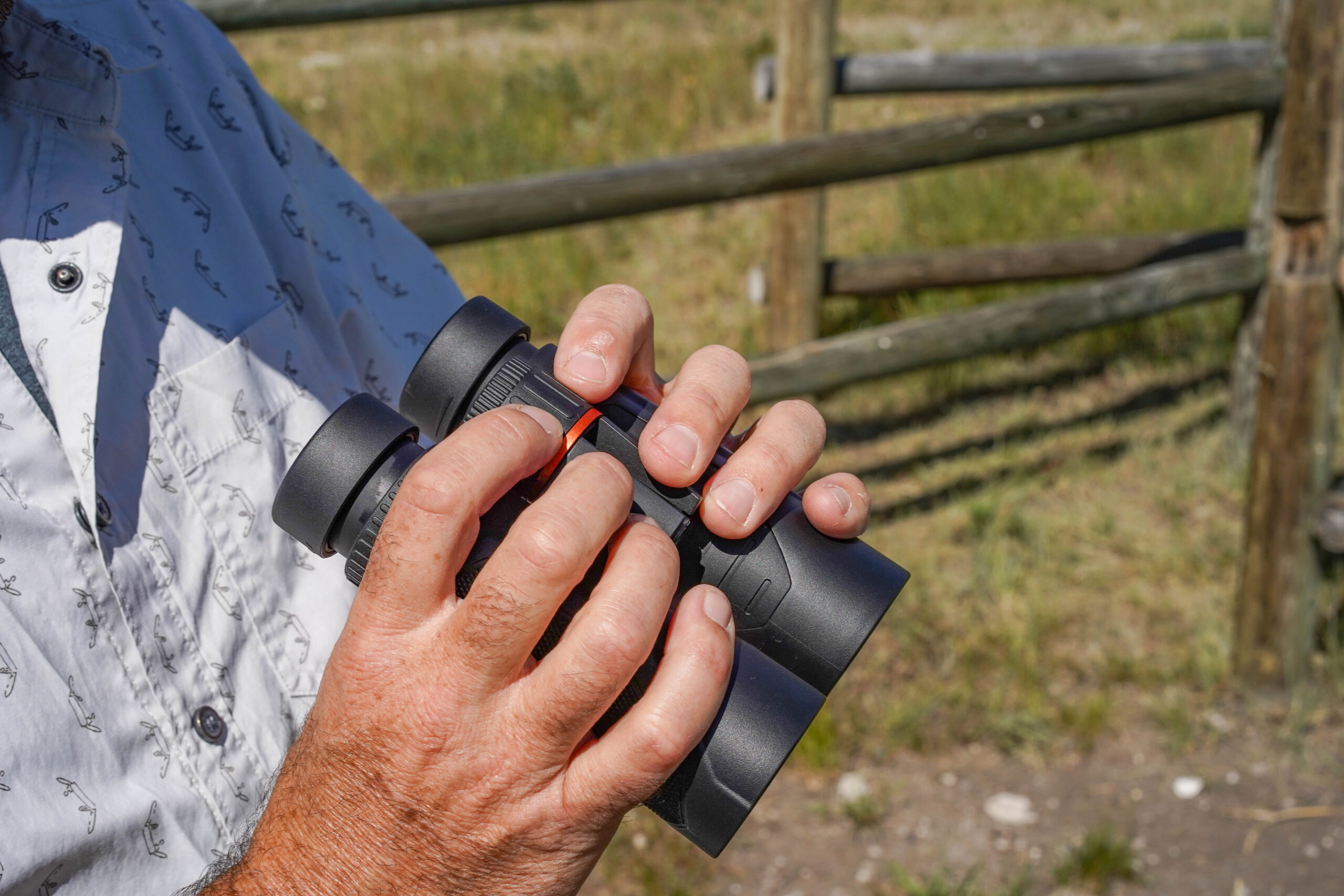
Its orange accents and aggressive texturing help dress up the Argos, but there’s only so much brands can do to differentiate their binoculars. “Reminds me of the Redfield of a few years ago,” noted Idler. But overall, this is a solid submission that should provide steady service, if not memorable performance.
Leupold Alpine HD 10×42
Score Card
- Optical Performance: Good
- Mechanical Performance: Very Good
- Design: Good
- Price/Value: Very Good
Key Features
- Single-hinge, closed-bridge design
- 42mm roof prism
- Right-barrel diopter control
- Magnesium body
- Tripod adaptable
Pros
- Distinctive shadow-gray color
- Ships with best harness/case in our test
- Fully transferable lifetime warranty
- Oversized eyecups
- Excellent coatings
Cons
- Slick barrels
- Mediocre image
An excellent backup binocular or a good choice for a beginning hunter, birder, or outdoor person, Leupold’s Alpine HD is built around adequate glass that is boosted by the brand’s excellent optical coatings. Those coatings allow the budget binocular to hit above its weight (and price) in low-light performance and casual glassing.
But when subjected to the more rigorous measurements of optical performance in our test, the binocular’s “high-definition” glass quality showed some shortcomings. First was optical resolution, which is a measurement of crispness and clarity, where the Leupold scored in the lower third of submissions. And testers noticed a distracting ripple in the bottom of both barrels. Mechanically, the Alpine HD performed fine, but testers wanted both the diopter and focus controls to be slightly tighter.
Testers loved the oversized, textured eyecups and the fingertip sensitivity of the focus knob. And Leupold won unanimous praise for including its GO Afield binocular case and harness with the Alpine HD. That, plus the company’s excellent lifetime warranty, gave the binocular very good price/value scores as an optic that’s well worth the money.
Hawke Vantage 8×32
Score Card
- Optical Performance: Fair
- Mechanical Performance: Good
- Design: Fair
- Price/Value: Very Good
Key Features
- 8-power compact design
- Closed-bridge design
- Roof prism
- Tripod adaptable
- Right-barrel diopter control
- No-fault lifetime warranty
Pros
- Oversized focus wheel
- Ships with carry bag and strapped case
- Excellent 6.6-foot close focus
- Super compact and light (14.7 oz)
Cons
- Poor low-light performance
- Some debris in barrels
- Loose eyecups
As one of the only true compact binoculars in our budget bino category, the Hawke can’t quite stand with models that have significantly more glass and optical horsepower. But this new model is an excellent choice for a close-quarters deer hunter, a turkey hunter, or anyone who puts a premium on light weight and compact optics. Plus, the Vantage’s 6-foot close-focus capability makes it a good choice for birders and butterfly viewers.
If it’s not a long-ranger, then it’s also not an especially effective into-the-night viewer, either. It finished last in our low-light test (a performance that is to be expected with the 8×32 configuration) and posted only middling resolution scores. But testers felt the balance, in-hand feel, and general operation was on par for the platform; they especially liked the fingertip sensitivity of the oversized focus wheel.
The glass and coatings are better than we’d expect for a binocular that will retail for under $150. It’s a solid choice for those pursuits in which weight and dimensions are an issue, and the warranty further makes the case for its excellent value.
How to Choose a Budget Binocular
How much more performance do you really get with each additional $100 you spend on a binocular? That was a question that was central to our testers as we worked through this crop of budget (under $400) binos. Another way to look at the question: Is Maven’s C.1 really four times better than Vortex’s Triumph?
The answer is in the details. True ED glass probably is twice as good as regular glass, at least in terms of ease of viewing, edge-to-edge clarity, and the lack of distracting flares and sunspots. Same with premium components and a quality build. Put another way, will your $400 binocular last twice as long as a $200 binocular? Based on our assessments of mechanics, durability, and components, our answer is yes. It probably is worth saving up to spend a little more, even at the budget level.
But we hope our test makes you a more informed consumer. Don’t fall for meaningless terms like “HD” or “high-definition” glass or “high performance” optics. Instead, feel how solid and durable an optic feels in your hands, how comfortable it is to glass with, and how amenities like harness and case add value. And lastly, triple check warranty details. Especially with this category of optics, there’s every chance you’ll need it at some point.
FAQs
A 10-power binocular is considered the most versatile because it provides a good balance of field of view, compact size, and viewing objects at far distances. If you’re exclusively looking at objects far in the distance, a 12 or 15-power binocular used in conjunction with a tripod is a fantastic setup. Or if you are using your binoculars in tight quarters, an 8-power bino is an excellent choice.
You can spend as little as $100 or as much as $4,000 on binoculars. Generally, the more money you spend, the better the binocular, but because there’s a limit to your budget, you probably want to buy the best binocular for your money. The good news is there are lots of choices in the $400-$600 range. That’s still a lot of money, but here are three things to consider:
•Warranty – Does your brand have your back? Many optics companies offer fully transferrable lifetime warranties for binoculars. That means it’s covered for repair or replacement whether you bought the optic yourself or bought it second-hand.
•Accessories – Many brands include zippered cases or harnesses with their binoculars, a savings of around $50.
•Performance – If you spend $500 or more for an optic, you want to be sure it’s going to deliver. Look for models that have high light transmission (90 percent or higher), good customer reviews, and are built for battle, with double hinges, durable armor, and controls (focus wheels and eyecups) that move with precision and authority.
Final Thoughts on the Best Binoculars for the Money
Even brands that have built their reputation on premium optics—I’m thinking Leupold, Maven, and Nikon—have price-point products that are among the best binoculars for the money. Because these brands use coatings and components from their flagship products on these budget lines, they’re worth an extra look because they pack a lot of brand integrity into these entry-level products.
Lastly, think about how much more time you’ll spend behind binoculars that fit your face and hands and deliver a pleasing image compared with those that struggle to focus and cause you to squint and work extra hard to use. Your time is worth something, and those el-cheapo binoculars that you hardly use because they give you a headache—and consequently that you don’t spend any time using—aren’t worth the money compared with more expensive binoculars that deliver such a luscious image that you want to spend time behind them. Using this metric, think about the dollars-per-hour you invest in a binocular. If you’re only planning to use it casually and sporadically, maybe you can get by with the cheapest model. But if you’re planning to use the bino for extended periods and across the seasons, then spending more now will cost you less in the long run.
